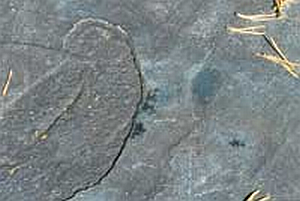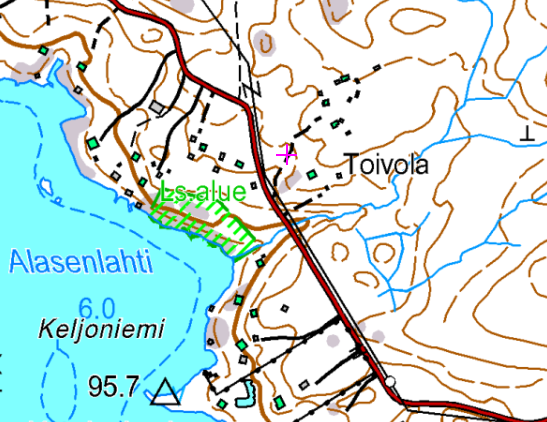Corycium enigmaticum
Myllyniemi(Aitolahti, Tampere)

Hiilipussien poikkileikkauksia Aitoniemen vaakunassa
Tampereella hellittiin pitkään ajatusta, että Tampereen ja erityisesti Aitolahden seudun kallioperä olisi lajissaan maailman vanhinta. Suomen kallioperä on pääasiassa koostunut kiteisistä kivilajeista, kuten graniitista ja gneissistä. Tämän peruskallion syntyikää on mahdotonta määritellä, mutta yleisesti sen syntyminen ajoitetaan prekambrikaudelle. Tämä tarkoittaa ajanjaksoa, joka alkoi maapallon syntyhetkellä noin 4,7 miljardia vuotta sitten ja päättyi monipuolista elämää kuvastavien fossiilien ilmestymiseen 570 miljoonaa vuotta sitten. Esimerkiksi Alpit ovat syntyneet "vain" noin 60 miljoonaa vuotta sitten
Aitolahden Hiilipussit

Kiteisten kalliomuodostumien lisäksi Tampereen seudulla esiintyy runsaasti erilaisia liuskekivilajeja. Alkujaan ne ovat olleet irtonaisia maakerroksia: soraa, hiekkaa ja savea sekä eloperäisiä jätteitä. Aitolahden kallioista on löydetty näiden jäänteitä, niin sanottuja Aitolahden hiilipussifossiileja, joita pitkään pidettiin koko maapallon vanhimpina elämän merkkeinä.
Pussit löydettiin 1890-luvulla ja geologisen tutkimuslaitoksen johtaja Jacob Johannes Sederholm antoi niille nimen Corycium enigmaticum, joka suomeksi tarkoittaa arvoituksellista pussia tai säkkiä. Myöhemmin on osoitettu, että Aitolahden hiilipussit eivät ole varsinaisia fossiileja vaan kiveä, joka sisältää pieniä, sinileviä muistuttavia mikrofossiileja. Niiden iäksi arvioidaan nykyisin noin kaksi miljardia vuotta. Myöhemmin on vastaavia, suunnilleen yhtä vanhoja fossiileja löydetty Länsi-Ontariosta ja Hudson Bayn pohjoisosasta Kanadasta. Swasimaasta ja Zimbabwesta, eteläisestä Afrikasta, on löydetty yksisoluisia levärakenteita, joista vanhimpien iäksi arvellaan noin 3400 miljoonaa vuotta. Länsi-Australiasta Warrawoona-vuoristosta on löydetty jopa 3465 miljoonan vuoden ikäisiä hiilifossiileja. Siis ainakin toistaiseksi maailman vanhimpia.
Pussien rakenne ja niiden synty
Coryciumin hiiliaines on hiilen isotooppikoostumuksen perusteella eloperäistä. Se syntyi alkeellisen mikrobitoiminnan tuloksena, mutta Coryciumin muoto ei ole fossiilin muoto. Corycium-fragmentteja ilmeisesti muodostui, kun turbidiittivyöry tempaisi mukaansa aiemmin kerrostuneista pienirakeisista sedimenteistä palasia, joiden pintaan tarttui eloperäistä aineista kappaleiden pyöriessä vyöryssä.
Hiilipussit ovat siis syntyneet savipalloista, joiden pintaan on muinoin tarttunut eliöpitoista liejua. Savipallojen ympärille kertynyt orgaaninen aines näkyy kiven pinnassa hiilikerroksena. Myllyniemi-muodostuman metaturbidiiteissa (fylliitti, liuskekivi) tavataan ellipsoidimaisia tai pallomaisia pienirakeisia kappaleita. Niitä ympäröi hiilestä rikkaan aineksen iskostama reunus, joka rapautuu ympäristöään herkemmin. Sederholm kutsui kappaleita nimellä Corycium enigmaticum ja arveli niiden olevan pussimaisten levien jäänteitä ja muodoiltaan aitoja fossiileja.
Lisää tietoa:
Hirviniemen kylä, Metsä-Kiikkinen RN:o 14
Peruskarttalehti 2123 12 B
Lääninhallituksen päätösnro 102/VI, 15.2.1962
Lehtinen, M., Nurmi, P. & Rämö, T. 1998: Suomen kallioperä: 3000 vuosimiljoonaa. Suomen geologinen seura
Kätkön loggaus:
Hiilipussit sijaitsevat suojelualueella, joka kattaa n. 100 metrin levyisen rantakaistaleen.
Ylimääräinen waypoint osoittaa polulle, jota pitkin pääsee suojelualueelle ja rantaan.
Liikuthan varoen suojelualueella.

Logataksesi kätkön lähetä sähköpostiviesti (ei messenger) kätkön omistajalle. Kirjoita ensimmäiselle riville Corycium enigmaticum ja vastaa seuraaviin kysymyksiin:
1. Nimeä kaksi syytä, miksi Suomessa on erittäin vähän fossiileja?
2. Mistä suurin osa Suomesta löydetyistä fossiileista on löydetty ja miksi?
3. Mikä on suurimman löytämäsi hiilipussin pituus?
Vapaaehtoinen: Halutessasi voit liittää kuvan alueesta loggauksesi mukana.
Ei ole tarvetta odottaa vastausta ennen loggausta.
[in English]
Corycium enigmaticum
For a long time Tampere hold on the idea that Tampere, and in particular the Aitolahti region's native bedrock would be the oldest of its kind in the world. Finnish bedrock consists mainly of crystalline rocks such as granite and gneiss. The age of the bedrock is impossible to define, but generally it's originated from the precambrian period. It means the period that begins at the time the Earth was born about 4.7 billion years ago and ends when fossils of diversed form of life began to appear around 570 million years ago (For example, the Alps were born "only" about 60 million years ago..)
Aitolahti carbon bags
In addition to these crystalline rock formations there is also a variety of phyllis formations in Tampere region. Originally they were loose soil layers: gravel, sand and clay and organic material. From Aitolahti shore rocks have been found remnants of the organic material. So-called Aitolahti carbon bag fossils were for a long time considered to be the oldest signs of life on the entire planet.
The bags were found in 1890's and were named by Jacob Johannes Sederholm from the Finnish geological institute as Corycium enigmaticum, which means mysterious carbon bags. Later it was shown that Aitolahti carbon bags are not real fossil, but stone, which consists of small, blue-green algae alike micro fossils. The age of the carbon bags is currently estimated to be about two billion years. Later, similar, about as old fossils have been found from the western part of Ontario and the northern part of Hudson Bay in Canada. From Zimbabwe and Swaziland, in Southern Africa, have also been found unicellular algae structures. The oldest have been dated around 3400 million years back. From western Australia-Warrawoona mountains have been found up to 3465 million years old carbon fossils. So far, the oldest in the world.
The formation and structure of the bags
The isotopic composition of carbon material of Corycium shows that the origin of the material has been organic. The material was a result of primitive microbiological activity, but the form of the Corycium is not the form of the fossil. Corycium fragments were apparently formed when a turbidite stream or avalanche pulled pieces of earlier sedimented small grained sediments with it. When the small pieces rolled in the avalanche they were covered by organic material.
So, carbon bags were originally formed of clay balls. The surface of balls has been adherred by silt that contains organic material. The accumulated organic material around clay balls is visible on the surface of stone as a layer of carbon. From the metaturbidites (phyllite, slate) in Myllyniemi formation has been found ellipsoidal or spherical small grain particles. They are surrounded by an edge of carbon-rich material, which erodes more easily than it's surroundings. Sederholm called the formations as Corycium enigmaticum and thought them to be relicts of bag shaped algae and real fossils.
Logging the cache:
Carbon bags are located inside nature conservation area. Conservated area is around 100 meters wide shore line.
There is an additional waypoint showing the position of a trailhead to the conservation area.
Please be careful when moving in the conservation area.
You can reach the are also by city bus: take the line 28, from Pyynikintori square to Sorila. From there the line splits to west (Aitoniemi), north (Kämmenniemi - Terälahti - Kaanaa) and east (Viitapohja). Take the Aitoniemi-bound bus.
To log the cache contact the author with an email message (not messenger) that has text Corycium enigmaticum as the first line and answer to following questions:
1. Name two reasons why there are only a few fossils found from Finland?
2. What is the most fossil rich area in Finland and why?
3. What is the length of the largest carbon bag you can find?
Optional: I'd appreciate to see a nice photo of the area with your logging.
You don't have to wait for the answer before logging..